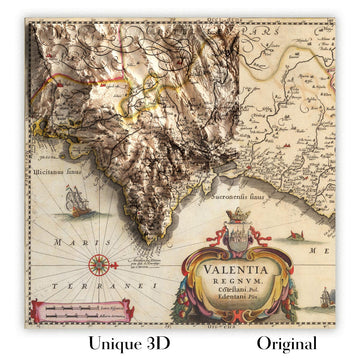

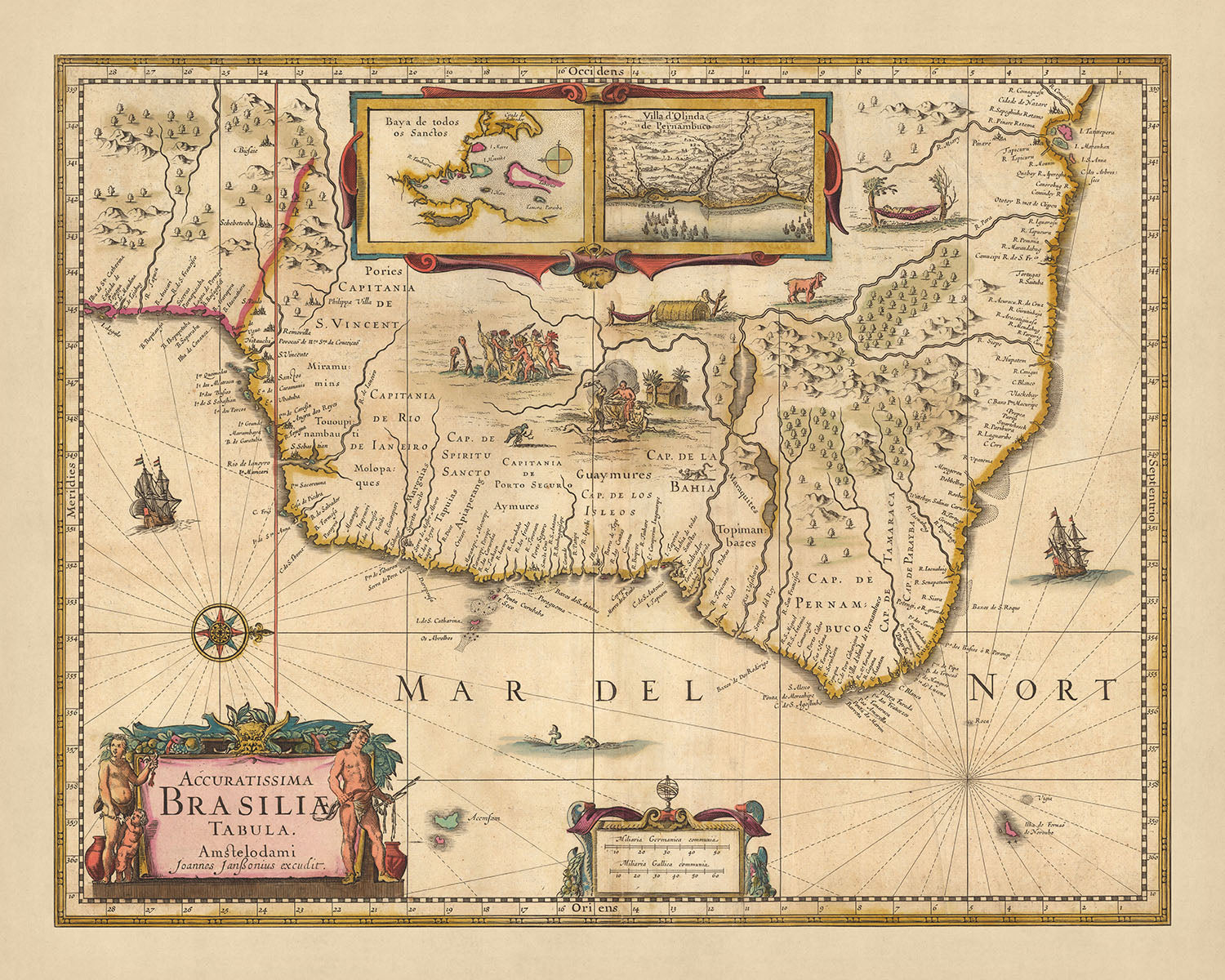

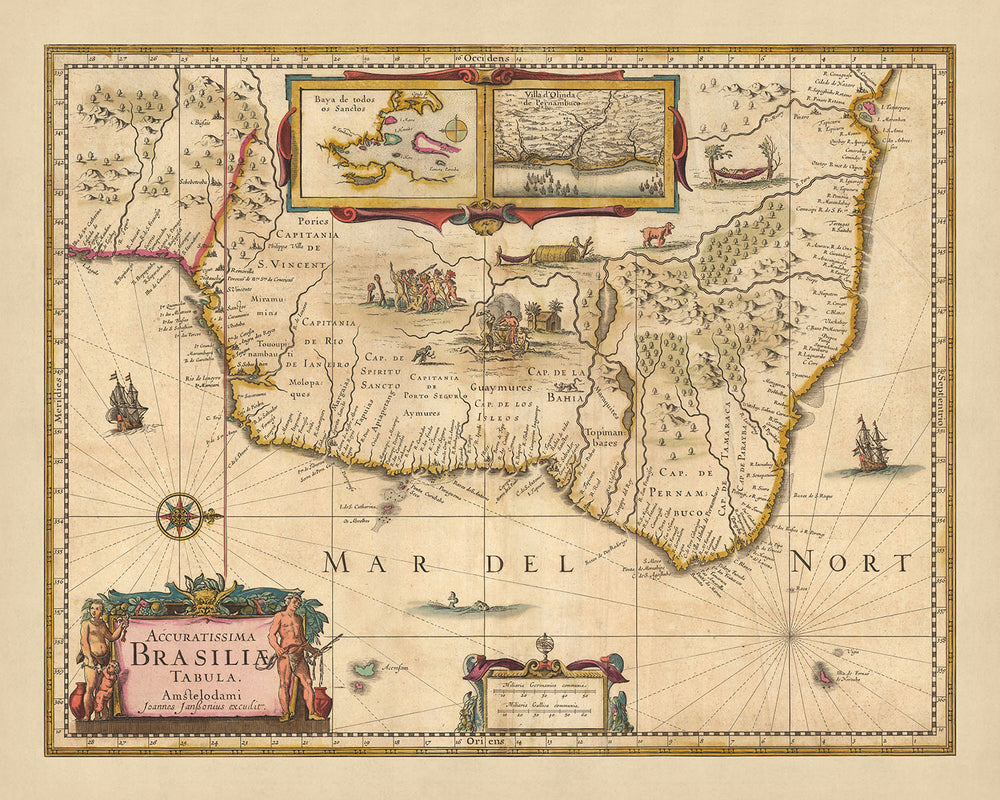

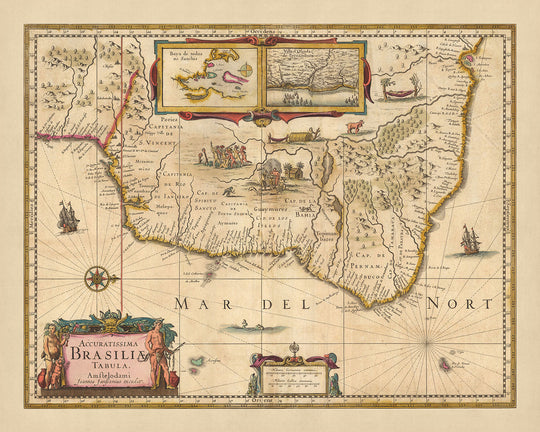











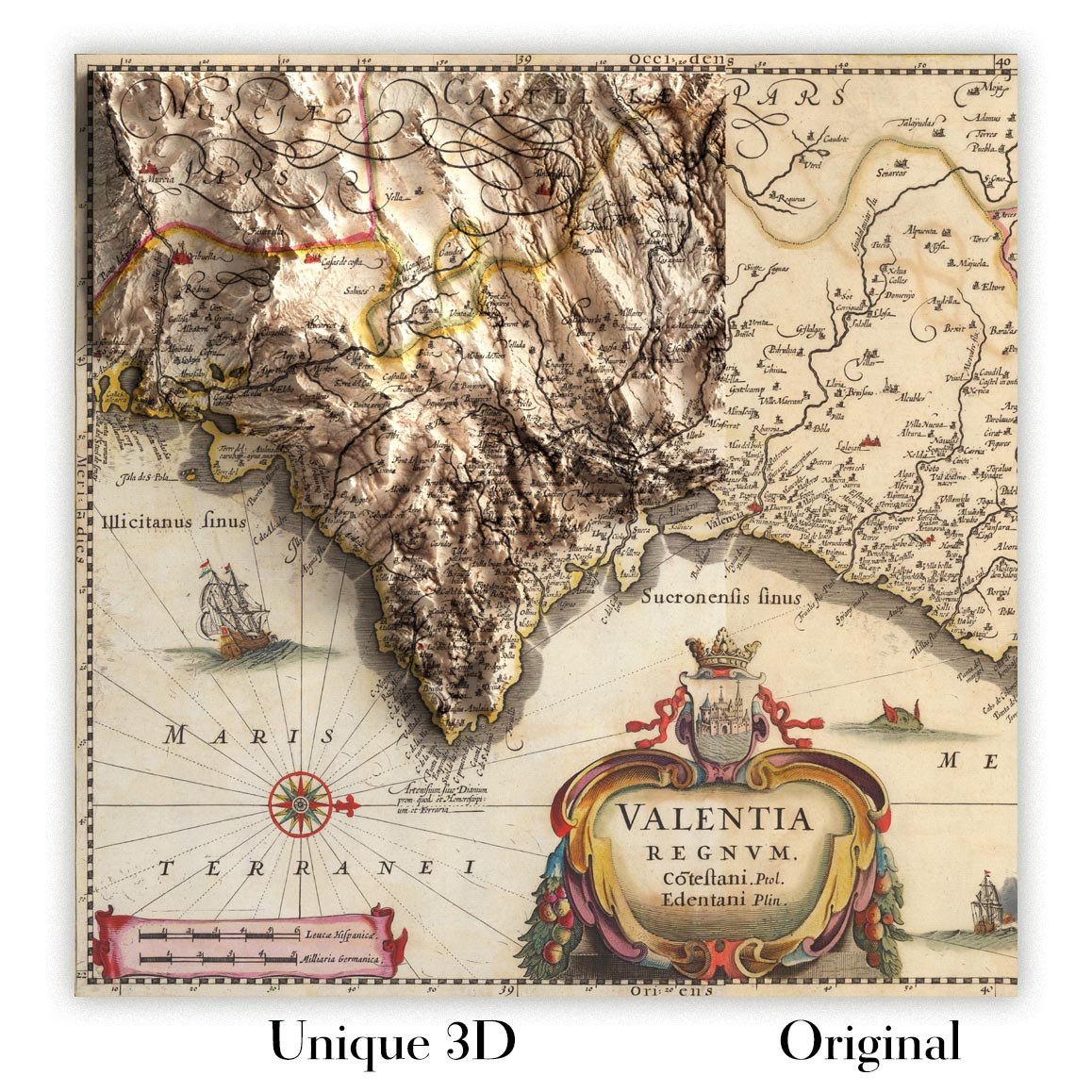



Old Map of Brazil by Visscher, 1690: Rio De Janeiro, São Paulo, Salvador, São Luís, Natal


-
![]() Handmade in the USA
Handmade in the USA
-
FREE worldwide delivery in 2-3 days ⓘ
Free Christmas delivery in 2-3 days
Your map should be delivered in 2-3 working days with free delivery, worldwide.
We make maps by hand locally in 23 countries, including the USA
![]() . If you're buying a gift for someone in another country, we will make the map locally to them.
. If you're buying a gift for someone in another country, we will make the map locally to them.You will never pay import tax or customs duty.
Check the Christmas delivery guide for order deadlines.
Express delivery is available at checkout which can reduce the delivery time to 1-2 days.
Please note that personalised maps, and larger framed maps, can take longer to produce and deliver.
If you need your order to arrive by a certain date, contact me and we can discuss your options.
-
90 day money back guarantee
ⓘ
90 days to return and refund
Products can be returned within 90 days for a full refund, or exchange for another product.
For personalised and custom made items, we may offer you store credit or a non-expiring gift card, as we cannot resell personalised orders.
If you have any questions, get in touch. For more information, see our full returns & exchanges policy.

My maps are rare, museum-grade, restored old maps sourced from libraries, auction houses and private collections across the globe.
Framing & free personalisation available
1. Select your size
➢ Pick the closest size (above)
➢ Provide the exact size in millimetres
➢ Add to bag and checkout as normal
2. Frame & personalize your map
Make your map unique with framing, hand-drawn customisation, vintage ageing, pop art text, unique 3D styling and moreGift message & custom finish

If you want to add a gift message, or a finish (jigsaw, aluminium board, etc.) that is not available here, please request it in the "order note" when you check out.
Every order is custom made, so if you need the size adjusted slightly, or printed on an unusual material, just let us know. We've done thousands of custom orders over the years, so there's (almost) nothing we can't manage.
You can also contact us before you order, if you prefer!

- Handmade locally. No import duty or tax
- FREE Delivery. Arrives in 2-3 days
- Love it or your money back
- Questions? WhatsApp me any time
Own a piece of history
5,000+ 5 star reviews


Dive into the rich history and breathtaking geography of Brazil with the exquisite 'Accuratissima Brasiliae tabula', translated to 'The Most Accurate Map of Brazil', a meticulously crafted map from 1690 by the renowned mapmaker Nicolaes Visscher II. This splendid cartographic masterpiece captures the essence of Brazil during the late 17th century, providing a glimpse into the past with its depiction of political divisions and regions that compose the modern day area of Brazil. Visscher, a descendant of the illustrious mapmaker Claes Janszoon Visscher, brings his family's tradition of precision and artistry to this unique piece.
The map features significant cities like Rio De Janeiro, São Paulo, Salvador, São Luís, and Natal, each marked with meticulous detail. Beyond the urban landscapes, the map also highlights various natural elements, such as waterways, canals, and mountains, that contribute to the diverse Brazilian terrain. The hand-colored outlines and engraved details add a layer of visual appeal, making this map not just a historical document, but a work of art.
An interesting aspect of this map is the inclusion of decorative cartouches, a compass rose, and a vignette of ships in the ocean and native settlements inland. These details offer a sense of the era's aesthetic sensibilities and navigational practices. The relief shown pictorially further enhances the map's visual appeal, providing a three-dimensional perspective that brings the landscape to life.
The 'Accuratissima Brasiliae tabula' is more than just a map—it's a testament to the craftsmanship of the Dutch Golden Age, a window into Brazil's past, and a captivating piece of art. Whether you're a history enthusiast, a lover of maps, or simply someone who appreciates fine art, this map is a valuable addition to any collection. Its intricate details and historical significance make it a fascinating conversation piece, sure to intrigue and inspire.
Some of the significant locations shown on this map:
Cities in the Captaincy of Rio de Janeiro 1. Rio de Janeiro - Known as São Sebastião do Rio de Janeiro, it was founded in 1565. It is notable for its natural harbor, the Guanabara Bay. 2. São Paulo - Founded in 1554 as São Paulo dos Campos de Piratininga, it is known for its historical Jesuit mission.
Cities in the Captaincy of Bahia 1. Salvador - Founded in 1549, it was the first capital of Brazil and a major port for the slave trade. 2. Ilhéus - Known as Vila de São Jorge dos Ilhéus, it was founded in 1534 and is famous for its cocoa plantations. 3. Porto Seguro - Founded in 1534, it is where Pedro Álvares Cabral first landed in Brazil.
Cities in the Captaincy of Pernambuco 1. Recife - Founded in 1537, it was the main harbor of the captaincy and known for its sugar cane plantations. 2. Olinda - Founded in 1535, it was the original capital of the captaincy.
Cities in the Captaincy of São Vicente 1. Santos - Founded in 1546, it was a major port for the export of coffee and sugar.
Cities in the State of Maranhão 1. São Luís - Founded in 1612, it was the French's first attempt to settle in Brazil. 2. Belém - Founded in 1616, it was the gateway for Portuguese exploration of the Amazon.
Cities in the Captaincy of Espírito Santo 1. Vitória - Founded in 1551, it was a strategic location for the defense against French privateers.
Cities in the Captaincy of Paraíba 1. João Pessoa - Founded in 1585, it was a key location for the sugar industry.
Cities in the Captaincy of Rio Grande 1. Natal - Founded in 1599, it was a strategic location for the Portuguese against French and Dutch invasions.
The remaining 17 cities were smaller settlements, but still of historical significance.
Notable Natural Phenomena - Amazon River - One of the longest rivers in the world, it is a major waterway for transport and trade. - Pantanal - The world's largest tropical wetland, it is home to a diverse range of wildlife. - Iguaçu Falls - Located on the border of Argentina and Brazil, it is one of the world's largest waterfalls. - Serra da Capivara National Park - Known for its prehistoric rock paintings. - Fernando de Noronha - An archipelago known for its rich marine biodiversity.
Historical Events - The Dutch occupation of northeastern Brazil (1630-1654) - This was a significant period of conflict and cultural exchange. - The Battle of Guararapes (1648-1649) - Marked the beginning of the end of Dutch occupation in Brazil. - The discovery of gold in the region of Minas Gerais (1693) - This led to the largest gold rush in Latin America.
Please double check the images to make sure that a specific town or place is shown on this map. You can also get in touch and ask us to check the map for you.
This map looks great at all sizes: 12x16in (30.5x41cm), 16x20in (40.5x51cm), 18x24in (45.5x61cm), 24x30in (61x76cm), 32x40in (81.5x102cm), 40x50in (102x127cm), 48x60in (122x153cm) and 56x70in (142x178cm), but it looks even better when printed large.
I can create beautiful, large prints of this map up to 90in (229cm). Please get in touch if you're looking for larger, customised or different framing options.
The model in the listing images is holding the 16x20in (40.5x51cm) version of this map.
The fifth listing image shows an example of my map personalisation service.
If you’re looking for something slightly different, check out my collection of the best old maps of Europe and European cities to see if something else catches your eye.
Please contact me to check if a certain location, landmark or feature is shown on this map.
This would make a wonderful birthday, Christmas, Father's Day, work leaving, anniversary or housewarming gift for someone from the areas covered by this map.
This map is available as a giclée print on acid free archival matte paper, or you can buy it framed. The frame is a nice, simple black frame that suits most aesthetics. Please get in touch if you'd like a different frame colour or material. My frames are glazed with super-clear museum-grade acrylic (perspex/acrylite), which is significantly less reflective than glass, safer, and will always arrive in perfect condition.
This map is also available as a float framed canvas, sometimes known as a shadow gap framed canvas or canvas floater. The map is printed on artist's cotton canvas and then stretched over a handmade box frame. We then "float" the canvas inside a wooden frame, which is available in a range of colours (black, dark brown, oak, antique gold and white). This is a wonderful way to present a map without glazing in front. See some examples of float framed canvas maps and explore the differences between my different finishes.
For something truly unique, this map is also available in "Unique 3D", our trademarked process that dramatically transforms the map so that it has a wonderful sense of depth. We combine the original map with detailed topography and elevation data, so that mountains and the terrain really "pop". For more info and examples of 3D maps, check my Unique 3D page.
For most orders, delivery time is about 3 working days. Personalised and customised products take longer, as I have to do the personalisation and send it to you for approval, which usually takes 1 or 2 days.
Please note that very large framed orders usually take longer to make and deliver.
If you need your order to arrive by a certain date, please contact me before you order so that we can find the best way of making sure you get your order in time.
I print and frame maps and artwork in 23 countries around the world. This means your order will be made locally, which cuts down on delivery time and ensures that it won't be damaged during delivery. You'll never pay customs or import duty, and we'll put less CO2 into the air.
All of my maps and art prints are well packaged and sent in a rugged tube if unframed, or surrounded by foam if framed.
I try to send out all orders within 1 or 2 days of receiving your order, though some products (like face masks, mugs and tote bags) can take longer to make.
If you select Express Delivery at checkout your order we will prioritise your order and send it out by 1-day courier (Fedex, DHL, UPS, Parcelforce).
Next Day delivery is also available in some countries (US, UK, Singapore, UAE) but please try to order early in the day so that we can get it sent out on time.
My standard frame is a gallery style black ash hardwood frame. It is simple and quite modern looking. My standard frame is around 20mm (0.8in) wide.
I use super-clear acrylic (perspex/acrylite) for the frame glass. It's lighter and safer than glass - and it looks better, as the reflectivity is lower.
Six standard frame colours are available for free (black, dark brown, dark grey, oak, white and antique gold). Custom framing and mounting/matting is available if you're looking for something else.
Most maps, art and illustrations are also available as a framed canvas. We use matte (not shiny) cotton canvas, stretch it over a sustainably sourced box wood frame, and then 'float' the piece within a wood frame. The end result is quite beautiful, and there's no glazing to get in the way.
All frames are provided "ready to hang", with either a string or brackets on the back. Very large frames will have heavy duty hanging plates and/or a mounting baton. If you have any questions, please get in touch.
See some examples of my framed maps and framed canvas maps.
Alternatively, I can also supply old maps and artwork on canvas, foam board, cotton rag and other materials.
If you want to frame your map or artwork yourself, please read my size guide first.
My maps are extremely high quality reproductions of original maps.
I source original, rare maps from libraries, auction houses and private collections around the world, restore them at my London workshop, and then use specialist giclée inks and printers to create beautiful maps that look even better than the original.
My maps are printed on acid-free archival matte (not glossy) paper that feels very high quality and almost like card. In technical terms the paper weight/thickness is 10mil/200gsm. It's perfect for framing.
I print with Epson ultrachrome giclée UV fade resistant pigment inks - some of the best inks you can find.
I can also make maps on canvas, cotton rag and other exotic materials.
Learn more about The Unique Maps Co.
Map personalisation
If you're looking for the perfect anniversary or housewarming gift, I can personalise your map to make it truly unique. For example, I can add a short message, or highlight an important location, or add your family's coat of arms.
The options are almost infinite. Please see my map personalisation page for some wonderful examples of what's possible.
To order a personalised map, select "personalise your map" before adding it to your basket.
Get in touch if you're looking for more complex customisations and personalisations.
Map ageing
I have been asked hundreds of times over the years by customers if they could buy a map that looks even older.
Well, now you can, by selecting Aged before you add a map to your basket.
All the product photos you see on this page show the map in its Original form. This is what the map looks like today.
If you select Aged, I will age your map by hand, using a special and unique process developed through years of studying old maps, talking to researchers to understand the chemistry of aging paper, and of course... lots of practice!
If you're unsure, stick to the Original colour of the map. If you want something a bit darker and older looking, go for Aged.
If you are not happy with your order for any reason, contact me and I'll get it fixed ASAP, free of charge. Please see my returns and refund policy for more information.
I am very confident you will like your restored map or art print. I have been doing this since 1984. I'm a 5-star Etsy seller. I have sold tens of thousands of maps and art prints and have over 5,000 real 5-star reviews. My work has been featured in interior design magazines, on the BBC, and on the walls of dozens of 5-star hotels.
I use a unique process to restore maps and artwork that is massively time consuming and labour intensive. Hunting down the original maps and illustrations can take months. I use state of the art and eye-wateringly expensive technology to scan and restore them. As a result, I guarantee my maps and art prints are a cut above the rest. I stand by my products and will always make sure you're 100% happy with what you receive.
Almost all of my maps and art prints look amazing at large sizes (200cm, 6.5ft+) and I can frame and deliver them to you as well, via special oversized courier. Contact me to discuss your specific needs.
Or try searching for something!
This service is currently unavailable,
sorry for the inconvenience.
Pair it with a frame
Frame options are for visualization purposes only.
FRAME STYLE
MATTING SIZE
BUILDING YOUR EXPERIENCE
powered by Blankwall
Take a few steps back and let your camera see more of the scene.
powered by Blankwall
Was this experience helpful?
Dive into the rich history and breathtaking geography of Brazil with the exquisite 'Accuratissima Brasiliae tabula', translated to 'The Most Accurate Map of Brazil', a meticulously crafted map from 1690 by the renowned mapmaker Nicolaes Visscher II. This splendid cartographic masterpiece captures the essence of Brazil during the late 17th century, providing a glimpse into the past with its depiction of political divisions and regions that compose the modern day area of Brazil. Visscher, a descendant of the illustrious mapmaker Claes Janszoon Visscher, brings his family's tradition of precision and artistry to this unique piece.
The map features significant cities like Rio De Janeiro, São Paulo, Salvador, São Luís, and Natal, each marked with meticulous detail. Beyond the urban landscapes, the map also highlights various natural elements, such as waterways, canals, and mountains, that contribute to the diverse Brazilian terrain. The hand-colored outlines and engraved details add a layer of visual appeal, making this map not just a historical document, but a work of art.
An interesting aspect of this map is the inclusion of decorative cartouches, a compass rose, and a vignette of ships in the ocean and native settlements inland. These details offer a sense of the era's aesthetic sensibilities and navigational practices. The relief shown pictorially further enhances the map's visual appeal, providing a three-dimensional perspective that brings the landscape to life.
The 'Accuratissima Brasiliae tabula' is more than just a map—it's a testament to the craftsmanship of the Dutch Golden Age, a window into Brazil's past, and a captivating piece of art. Whether you're a history enthusiast, a lover of maps, or simply someone who appreciates fine art, this map is a valuable addition to any collection. Its intricate details and historical significance make it a fascinating conversation piece, sure to intrigue and inspire.
Some of the significant locations shown on this map:
Cities in the Captaincy of Rio de Janeiro 1. Rio de Janeiro - Known as São Sebastião do Rio de Janeiro, it was founded in 1565. It is notable for its natural harbor, the Guanabara Bay. 2. São Paulo - Founded in 1554 as São Paulo dos Campos de Piratininga, it is known for its historical Jesuit mission.
Cities in the Captaincy of Bahia 1. Salvador - Founded in 1549, it was the first capital of Brazil and a major port for the slave trade. 2. Ilhéus - Known as Vila de São Jorge dos Ilhéus, it was founded in 1534 and is famous for its cocoa plantations. 3. Porto Seguro - Founded in 1534, it is where Pedro Álvares Cabral first landed in Brazil.
Cities in the Captaincy of Pernambuco 1. Recife - Founded in 1537, it was the main harbor of the captaincy and known for its sugar cane plantations. 2. Olinda - Founded in 1535, it was the original capital of the captaincy.
Cities in the Captaincy of São Vicente 1. Santos - Founded in 1546, it was a major port for the export of coffee and sugar.
Cities in the State of Maranhão 1. São Luís - Founded in 1612, it was the French's first attempt to settle in Brazil. 2. Belém - Founded in 1616, it was the gateway for Portuguese exploration of the Amazon.
Cities in the Captaincy of Espírito Santo 1. Vitória - Founded in 1551, it was a strategic location for the defense against French privateers.
Cities in the Captaincy of Paraíba 1. João Pessoa - Founded in 1585, it was a key location for the sugar industry.
Cities in the Captaincy of Rio Grande 1. Natal - Founded in 1599, it was a strategic location for the Portuguese against French and Dutch invasions.
The remaining 17 cities were smaller settlements, but still of historical significance.
Notable Natural Phenomena - Amazon River - One of the longest rivers in the world, it is a major waterway for transport and trade. - Pantanal - The world's largest tropical wetland, it is home to a diverse range of wildlife. - Iguaçu Falls - Located on the border of Argentina and Brazil, it is one of the world's largest waterfalls. - Serra da Capivara National Park - Known for its prehistoric rock paintings. - Fernando de Noronha - An archipelago known for its rich marine biodiversity.
Historical Events - The Dutch occupation of northeastern Brazil (1630-1654) - This was a significant period of conflict and cultural exchange. - The Battle of Guararapes (1648-1649) - Marked the beginning of the end of Dutch occupation in Brazil. - The discovery of gold in the region of Minas Gerais (1693) - This led to the largest gold rush in Latin America.
Please double check the images to make sure that a specific town or place is shown on this map. You can also get in touch and ask us to check the map for you.
This map looks great at all sizes: 12x16in (30.5x41cm), 16x20in (40.5x51cm), 18x24in (45.5x61cm), 24x30in (61x76cm), 32x40in (81.5x102cm), 40x50in (102x127cm), 48x60in (122x153cm) and 56x70in (142x178cm), but it looks even better when printed large.
I can create beautiful, large prints of this map up to 90in (229cm). Please get in touch if you're looking for larger, customised or different framing options.
The model in the listing images is holding the 16x20in (40.5x51cm) version of this map.
The fifth listing image shows an example of my map personalisation service.
If you’re looking for something slightly different, check out my collection of the best old maps of Europe and European cities to see if something else catches your eye.
Please contact me to check if a certain location, landmark or feature is shown on this map.
This would make a wonderful birthday, Christmas, Father's Day, work leaving, anniversary or housewarming gift for someone from the areas covered by this map.
This map is available as a giclée print on acid free archival matte paper, or you can buy it framed. The frame is a nice, simple black frame that suits most aesthetics. Please get in touch if you'd like a different frame colour or material. My frames are glazed with super-clear museum-grade acrylic (perspex/acrylite), which is significantly less reflective than glass, safer, and will always arrive in perfect condition.











